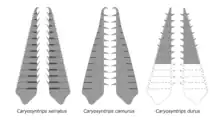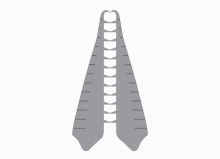| Caryosyntrips Temporal range: | |
|---|---|
 | |
| Frontal appendages of Caryosyntrips | |
 | |
| Speculative life restoration as a radiodont | |
| Scientific classification | |
| Domain: | Eukaryota |
| Kingdom: | Animalia |
| Stem group: | Arthropoda |
| Genus: | †Caryosyntrips Daley & Budd, 2010 |
| Type species | |
| Caryosyntrips serratus Daley & Budd, 2010 | |
| species | |
Caryosyntrips ("nutcracker") is an extinct genus of stem-arthropod which known from Canada, United States and Spain during the middle Cambrian.[1]
Description


Caryosyntrips was first named by Allison C. Daley, Graham E. Budd in 2010 and the type species is Caryosyntrips serratus.[3] Multiple species had been recovered from the Burgess Shale Formation, Canada, Wheeler Shale and Marjum Formation, United States, and Valdemiedes Formation, Spain.[1][4] The latter contain a large specimen, which was initially misidentified as a body remain of lobopodian ("Mureropodia apae").[5][1][6][2]
Caryosyntrips is known only from its 14-segmented frontal appendages, which resemble nutcrackers, with the endite (ventral spine)-bearing margin facing each other. the bell-shaped bases might represent movable articulations with the animal's head. Details of endites, terminal spines, segmental boundaries and outer margins differ between species.[1] Other structures remain unknown, although a specimen with paired appendages possibly contain other fragmental head sclerites as well.[3][4]
Caryosyntrips is thought to have used their frontal appendages in a scissor-like grasping or slicing motion, and were probably durophagous, feeding on hard-shelled organisms.[1]
Taxonomic affinities
As of 2010s, Caryosyntrips was long considered to be a basal radiodont of uncertain position, usually resolved in a polytomy between euarthropod and radiodont branches.[7][8][9][2][10][11] however more recent papers have found that it may sit outside of the monophyletic Radiodonta all together.[11][12] Due to the unusual morphology of the frontal appendages and the limited extent of known remains, its position within the arthropod stem-group remains uncertain.[1][12]
| Panarthropoda |
| |||||||||||||||||||||||||||||||||
See also
- Cucumericrus, another stem-arthropod with similar uncertainties.
References
- 1 2 3 4 5 6 7 8 Stephen Pates; Allison C. Daley (2017). "Caryosyntrips: a radiodontan from the Cambrian of Spain, USA and Canada". Papers in Palaeontology. 3 (3): 461–470. Bibcode:2017PPal....3..461P. doi:10.1002/spp2.1084. S2CID 135026011.
- 1 2 3 Lerosey-Aubril, Rudy; Pates, Stephen (2018-09-14). "New suspension-feeding radiodont suggests evolution of microplanktivory in Cambrian macronekton". Nature Communications. 9 (1): 3774. Bibcode:2018NatCo...9.3774L. doi:10.1038/s41467-018-06229-7. ISSN 2041-1723. PMC 6138677. PMID 30218075.
- 1 2 Allison C. Daley, Graham E. Budd (2010). "New anomalocaridid appendages from the Burgess Shale, Canada". Palaeontology. 53 (4): 721–738. Bibcode:2010Palgy..53..721D. doi:10.1111/j.1475-4983.2010.00955.x.
- 1 2 Pates, Stephen; Lerosey-Aubril, Rudy; Daley, Allison C.; Kier, Carlo; Bonino, Enrico; Ortega-Hernández, Javier (2021-01-19). "The diverse radiodont fauna from the Marjum Formation of Utah, USA (Cambrian: Drumian)". PeerJ. 9: e10509. doi:10.7717/peerj.10509. ISSN 2167-8359. PMC 7821760. PMID 33552709.
- ↑ Gámez Vintaned, José Antonio; Liñán, Eladio; Yu. Zhuravlev, Andrey (2011), Pontarotti, Pierre (ed.), "A New Early Cambrian Lobopod-Bearing Animal (Murero, Spain) and the Problem of the Ecdysozoan Early Diversification", Evolutionary Biology – Concepts, Biodiversity, Macroevolution and Genome Evolution, Berlin, Heidelberg: Springer, pp. 193–219, doi:10.1007/978-3-642-20763-1_12, ISBN 978-3-642-20763-1, retrieved 2024-01-05
- ↑ Pates, Stephen; Daley, Allison; Ortega-Hernández, Javier (2018). "Response to Comment on "Aysheaia prolata from the Utah Wheeler Formation (Drumian, Cambrian) is a frontal appendage of the radiodontan Stanleycaris" with the formal description of Stanleycaris". Acta Palaeontologica Polonica. 63. doi:10.4202/app.00443.2017. ISSN 0567-7920.
- ↑ Jakob Vinther; Martin Stein; Nicholas R. Longrich & David A. T. Harper (2014). "A suspension-feeding anomalocarid from the Early Cambrian" (PDF). Nature. 507 (7493): 496–499. Bibcode:2014Natur.507..496V. doi:10.1038/nature13010. PMID 24670770. S2CID 205237459.
- ↑ Cong, Peiyun; Ma, Xiaoya; Hou, Xianguang; Edgecombe, Gregory D.; Strausfeld, Nicholas J. (September 2014). "Brain structure resolves the segmental affinity of anomalocaridid appendages". Nature. 513 (7519): 538–542. Bibcode:2014Natur.513..538C. doi:10.1038/nature13486. ISSN 1476-4687. PMID 25043032. S2CID 4451239.
- ↑ Van Roy, Peter; Daley, Allison C.; Briggs, Derek E. G. (June 2015). "Anomalocaridid trunk limb homology revealed by a giant filter-feeder with paired flaps". Nature. 522 (7554): 77–80. Bibcode:2015Natur.522...77V. doi:10.1038/nature14256. ISSN 1476-4687. PMID 25762145. S2CID 205242881.
- ↑ Liu, Jianni; Lerosey-Aubril, Rudy; Steiner, Michael; Dunlop, Jason A; Shu, Degan; Paterson, John R (2018-06-01). "Origin of raptorial feeding in juvenile euarthropods revealed by a Cambrian radiodontan". National Science Review. 5 (6): 863–869. doi:10.1093/nsr/nwy057. ISSN 2095-5138.
- 1 2 Moysiuk, J.; Caron, J.-B. (2019-08-14). "A new hurdiid radiodont from the Burgess Shale evinces the exploitation of Cambrian infaunal food sources". Proceedings of the Royal Society B: Biological Sciences. 286 (1908): 20191079. doi:10.1098/rspb.2019.1079. ISSN 0962-8452. PMC 6710600. PMID 31362637.
- 1 2 McCall, Christian (13 December 2023). "A large pelagic lobopodian from the Cambrian Pioche Shale of Nevada". Journal of Paleontology: 1–16. doi:10.1017/jpa.2023.63. S2CID 266292707. Retrieved 13 December 2023.
External links
- "Caryosyntrips serratus". Burgess Shale Fossil Gallery. Virtual Museum of Canada. 2011. Archived from the original on March 23, 2023.
